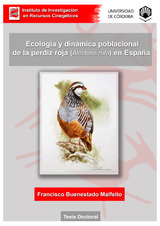Ecología y dinámica poblacional de la perdiz roja (Alectoris rufa) en España
Autor
Buenestado Malfeito, Francisco José
Director/es
Villafuerte, RafaelSánchez Tortosa, Francisco
Editor
Universidad de Córdoba, UCOPressFecha
2018Materia
Poblaciones silvestresAves
Perdiz roja (Alectoris rufa)
Hábitat
Dinámica de poblaciones
Ecología de poblaciones
España
METS:
Mostrar el registro METSPREMIS:
Mostrar el registro PREMISMetadatos
Mostrar el registro completo del ítemResumen
La perdiz roja está clasificada como SPEC categoría 2 (Species of European
Conservation Concern) basado en el marcado declive de sus poblaciones y su limitada
área de distribución, siendo más acusado este descenso poblacional durante la última
mitad del siglo XX. La calidad del hábitat juega un papel importante en la dinámica
poblacional de muchas especies, entre ellas la perdiz roja. Utilizando la técnica del
radiotraking (primer estudio que utiliza esta herramienta en poblaciones silvestres), se
han monitorizado diferentes poblaciones distribuidas en 4 áreas de estudio del sur y
centro de España. El amplio espectro de ambientes que se corresponde con el
mayoritario por el que se distribuye la especie, nos ha permitido averiguar las variables
ambientales que más influyen en la ecología espacial de la especie así como analizar las
causas de mortalidad, factores importantes en la dinámica de sus poblaciones, pudiendo
extraer conclusiones relevantes para la mejora de su gestión, como principal objetivo.
Se ha analizado la selección de hábitat a dos niveles: área de campeo y área de
estudio. Igualmente se averigua cuáles son los descriptores del paisaje que influyen en
el tamaño de las áreas de campeo. Se estudia si existen diferencias según el sexo, la
edad, condición física, estación del año o entre noche y día. Especial importancia ha
tenido el nivel de comparación entre fincas agrícolas muy manejadas y aquellas con
características opuestas a la hora de establecer conclusiones para la gestión.
La intensidad de la selección de hábitat se ve influenciada por el tamaño de parche en
las diferentes áreas de estudio.
Se han encontrado cuatro causas de muerte: caza, depredación, enfermedad y
traumatismo. La condición física, la diversidad de vegetación y la cantidad de lindes
afectan favorablemente a la supervivencia de la perdiz roja, estando asociadas negativamente estas dos últimas variables con la mortalidad por depredación y
enfermedad. Las enfermedades pueden jugar un importante papel en la dinámica
poblacional de la perdiz roja,
El capítulo 3 constituye el primer estudio epidemiológico de un brote de viruela
aviar realizado en una población silvestre de perdiz roja, y que se localizó en una de las
cuatro áreas de estudio donde predomina la agricultura, con alta densidad de perdiz y
muy gestionada cinegéticamente. Afectó al 41% de los juveniles.
En los estudios de los animales en los cuales se emplea la técnica de
radiotracking y estos son sometidos a un manejo previo, es necesario conocer los
posibles efectos negativos derivados de este manejo y su posible influencia en la
información que se trata de obtener. Se concluye como factores de riesgo el ajuste del
radioemisor, en nuestro caso el cuello de los animales, las condiciones climáticas y el
método y tiempo de captura, lo cual sería interesante tener en cuenta en posteriores
estudios. Red-legged partridge is classified as SPEC category 2 (Species of European
Conservation Concern) based on its marked population declines and because its
distribution is limited, being this population decline more pronounced for the half past
of the 20th century. The habitat quality plays an important role in the population
dynamics of the species, enough to red-legged partridge. Using the radio tracking
technique (first study which uses this tool in free-living populations), different
populations distributed in 4 study areas in southern and central Spain have been
monitored. The wide spectrum of environments corresponding to the main where the
species is found, has enabled to find out the environmental variables that more influence
the spatial ecology of the species as well as to analyse the causes of mortality, important
factors in the dynamic of its populations, being to extract important conclusions for the
improvement of its management, as main target.
The habitat selection has been analysed at two levels: home range and study area. By
the same token it is figured out which are the landscape descriptors that influence the
size of the home range. Possible differences depending on gender, age, body condition,
and season or between night and day are studied. Of particular importance has been the
comparison level between much handled agricultural properties and those with opposite
characteristics when stablishing conclusions concerning the management. The intensity
of habitat selection was affected by the average path size in each study area.
Four causes of death have been found: hunting, predation, disease and trauma.
The body condition, the diversity of vegetation and the number of edges favourably
affect the survival of the red-legged partridge, being negatively associated the last two
variables with predation mortality and disease. Diseases play an important role in the
population dynamic of the red-legged partridge. This is the first epidemiological investigation into an outbreak of avian pox in a freeliving
red-legged partridge population (chapter 3), located on one of the four study areas
where agriculture predominates, with high density of red-legged partridges and
synergistically well-handled. It affected 41% of the young partridges.
Studies on animals whereby radiotracking technique is used and which are
subjected to a previous management, it is necessary to know the potential negative
effects derived from this management and its potential influence in the information that
is sought. Therefore, it is concluded that factors such as the radio transmitter
adjustment, in our case the neck of the animals, the weather conditions and the method
and timing of capture are risk factors, which would be interesting to keep in mind for
further studies.

